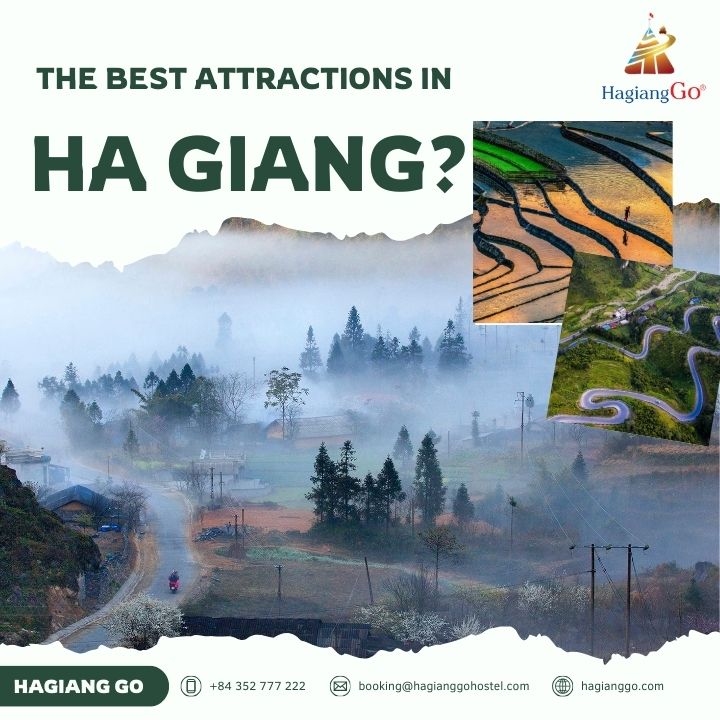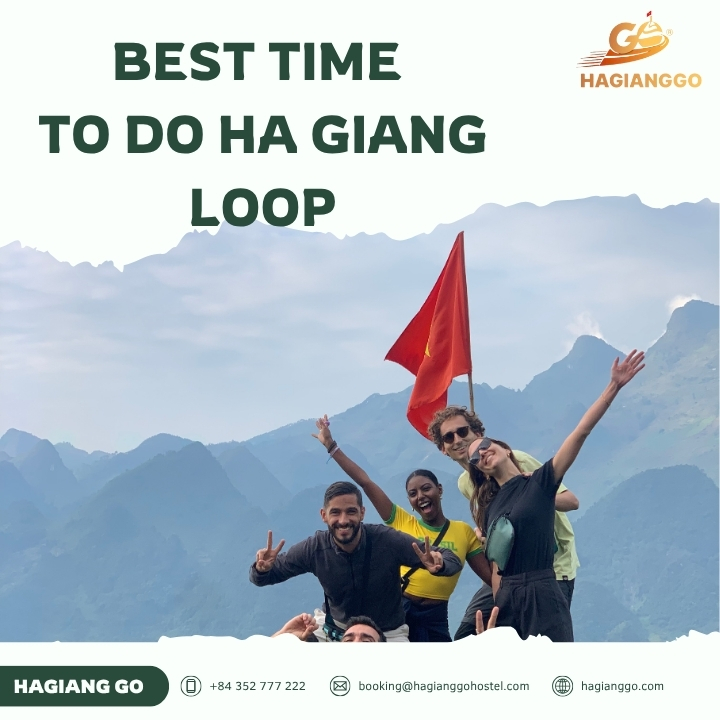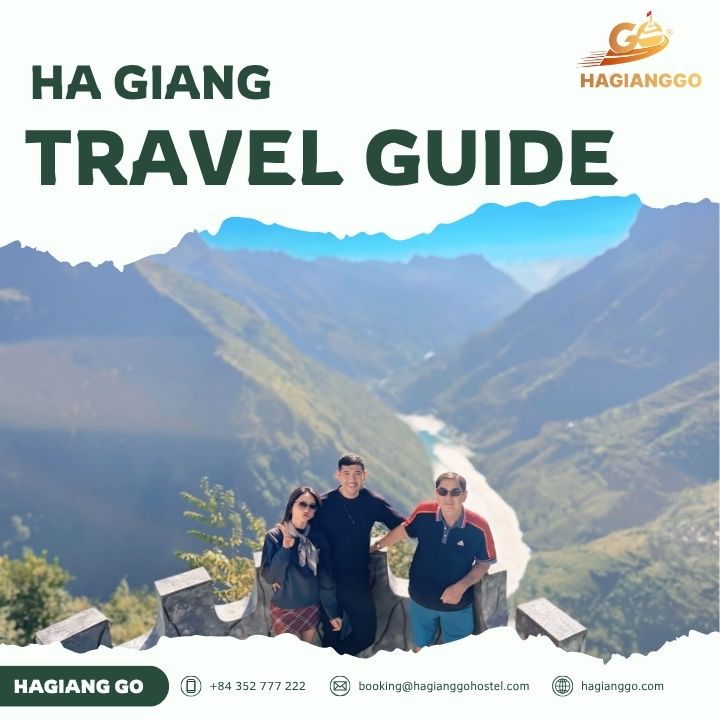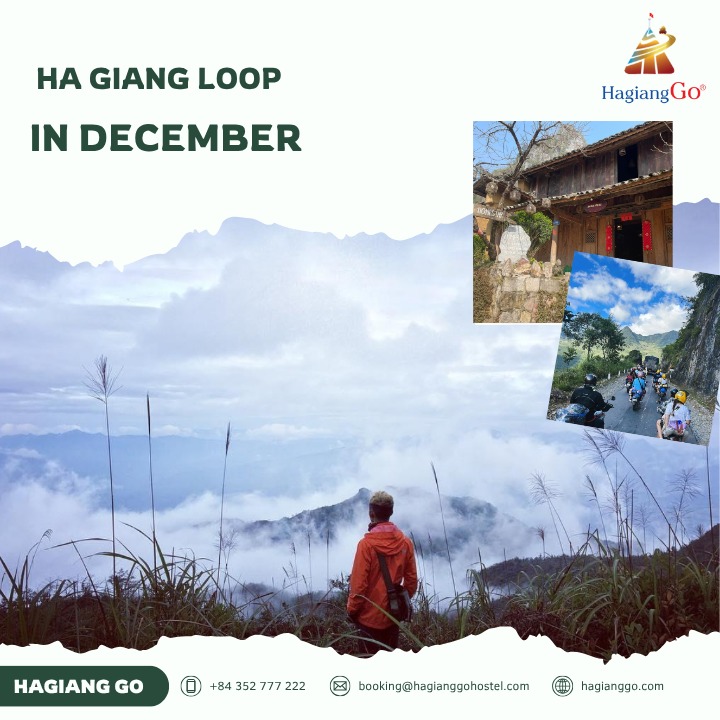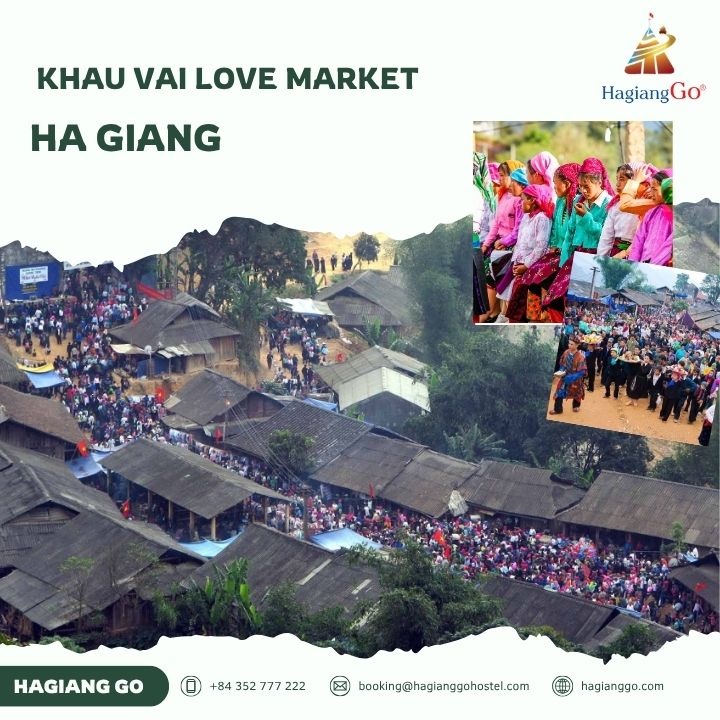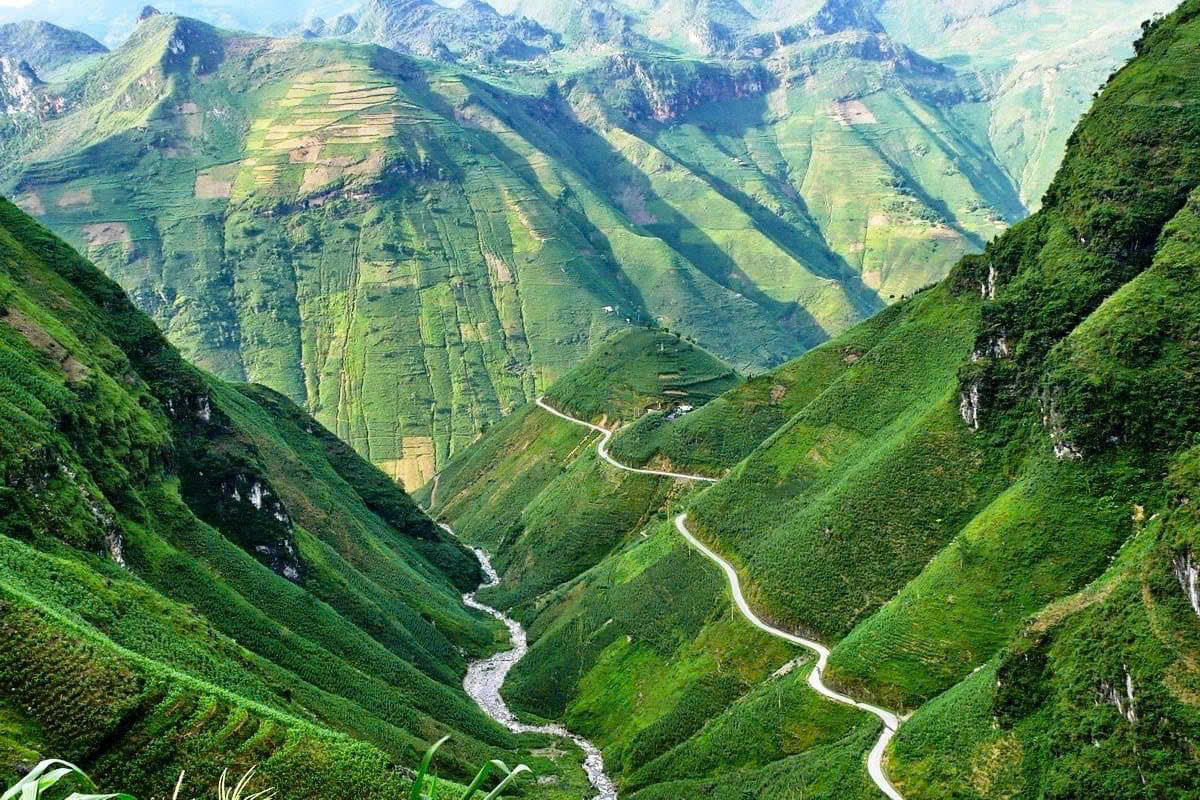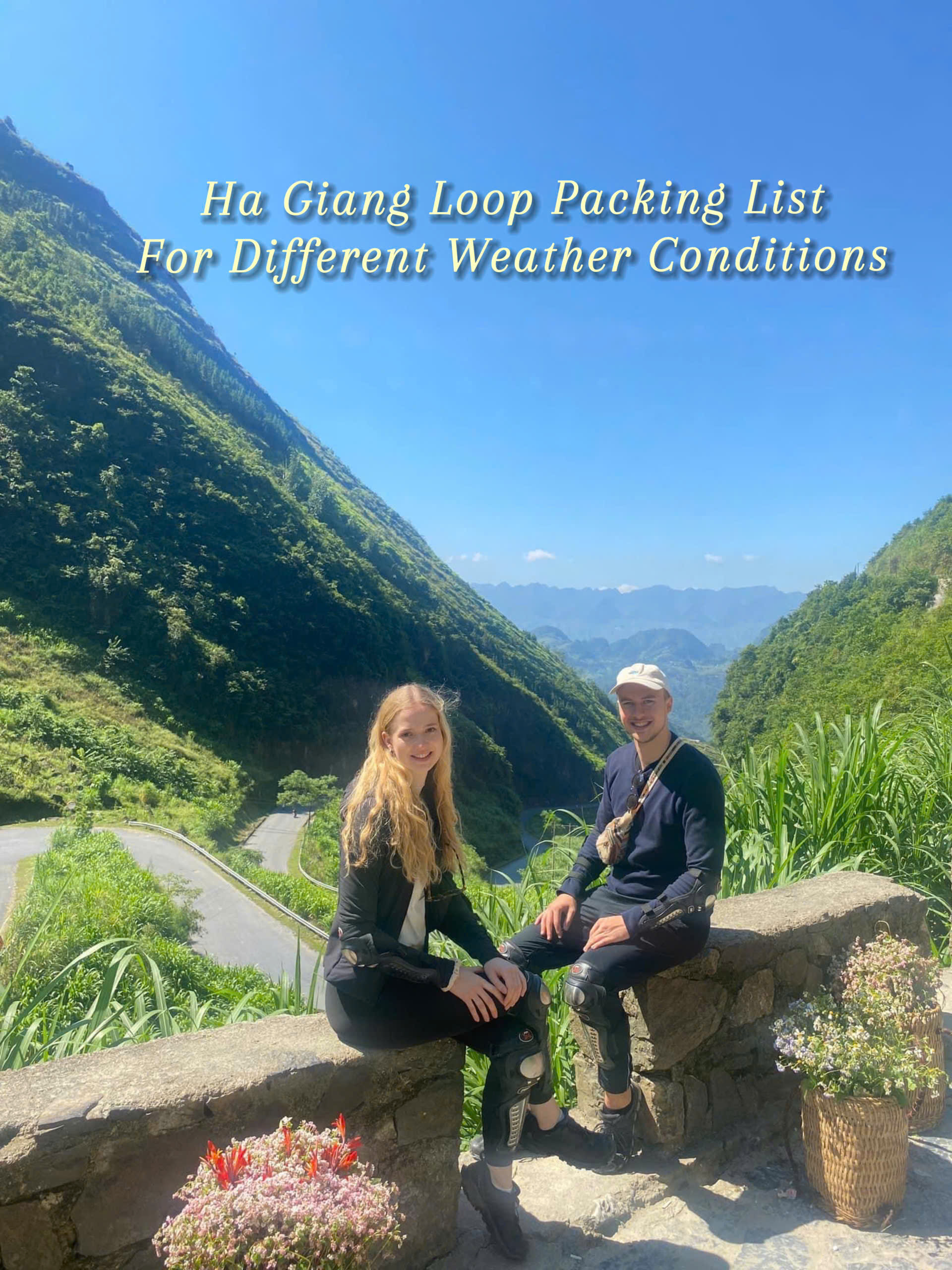1. Hoang Su Phi
Located in the western part of Ha Giang Province, Hoang Su Phi is a mountainous district comprising 24 communes and 1 town. This remote area is home to various ethnic minority groups, such as the Hmong, Tay, Nung, and La Chi. Renowned for its majestic scenery and cultural heritage, Hoang Su Phi is best known for its stunning terraced rice fields, which are recognised as Vietnam's heritage sites.
The Legendary Rice Terraces of Hoang Su Phi
The terraced rice fields in Hoang Su Phi cover approximately 3,700 hectares, with 1,380 hectares officially designated as a National Scenic Heritage Site. From late September to early October, the rice paddies turn golden, transforming the hills into a surreal canvas of rippling amber. Traditional wooden houses, ancient trees, and gentle mountain streams weave into this natural tapestry, creating a serene yet grandiose scene that captures the heart of every visitor.

Source: tuyengiao.hagiang.gov.vn
Cultural Encounters in Hoang Su Phi
Travellers to Hoang Su Phi are not only treated to visual splendour but also to meaningful cultural encounters. Each ethnic group here maintains its unique way of life, from architecture and clothing to farming practices and spiritual beliefs. You can join seasonal festivals, witness traditional dances, or enjoy the warm hospitality of local communities during a homestay experience.
Chieu Lau Thi Peak
Located about 42 km from the district centre, Chieu Lau Thi is one of the highest mountains in northeastern Vietnam. Often shrouded in mist and clouds, the peak offers panoramic views and a mystical atmosphere. The trek to the summit is ideal for nature lovers and photographers seeking dramatic mountain landscapes.
Tay Con Linh Mountain
Known as the “Roof of Northeastern Vietnam,” Tay Con Linh is a sacred mountain to many local ethnic groups and the region's highest peak. Surrounded by ancient forests and bathed in a cool, misty climate, it’s a prime destination for trekking and spiritual exploration with spectacular views over a sea of mountains.
2. Ma Pi Leng Pass
Situated on National Highway 4C, in Pai Lung Commune, Meo Vac District, Ha Giang Province, Ma Pi Leng Pass, stretching approximately 20 kilometres, is famously known as one of the “Four Great Passes” in Northwest Vietnam. Rising to approximately 1,200 meters above sea level, Ma Pi Leng Pass in Ha Giang is characterized by its steep and winding roads that cut through majestic, rugged landscapes, offering travelers both a thrilling challenge and spectacular views.
From the summit, visitors can admire the striking emerald-green Nho Que River weaving through the deep Tu San canyon, surrounded by towering mountains. This breathtaking scenery makes Ma Pi Leng a favoured destination not only for adventure seekers but also for those who wish to immerse themselves in the rich cultural heritage of the Dong Van Karst Plateau region.
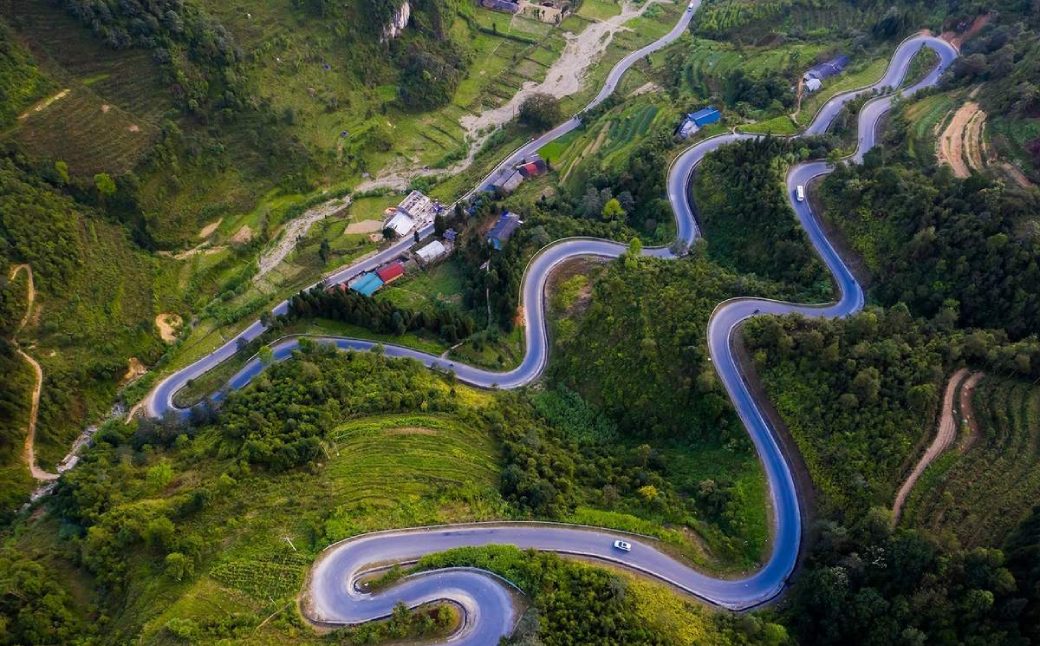
Source: Tien Nguyen
3. Nho Que River
Flowing through the heart of the Dong Van Karst Plateau, the Nho Que River is one of Ha Giang Province’s most iconic natural attractions. Originating from Yunnan Province in China, the river meanders through deep limestone gorges, carving out some of the most dramatic landscapes in northern Vietnam.
Known for its distinctive jade-green colour, Nho Que River flows through the spectacular Tu San Gorge, one of Southeast Asia’s deepest river gorges. Taking a boat ride on the Nho Que River is an unforgettable experience, offering travelers a chance to appreciate the pristine wilderness and grandeur of this remarkable natural wonder.
4. Tu San Gorge
Located beneath the Mã Pí Lèng Pass, Tu San Gorge is the deepest in Southeast Asia, with nearly vertical cliffs rising 700 to 900 meters and stretching about 1.7 kilometres long. The Nho Que River winds through the area like a bright green thread following the curves of the Happiness Road.
There are two ways to descend into Tu San Gorge:
- Option 1: A motorbike or car ride of around 8 km along winding, steep roads.
- Option 2: A 2 km walk along a cliffside path with steep stairs.
You must then take a boat or canoe upstream on the Nho Que River for 20–30 minutes to access the gorge itself. Currently, 23 tourism boats are operating here, welcoming thousands of visitors annually to admire this magnificent natural wonder.
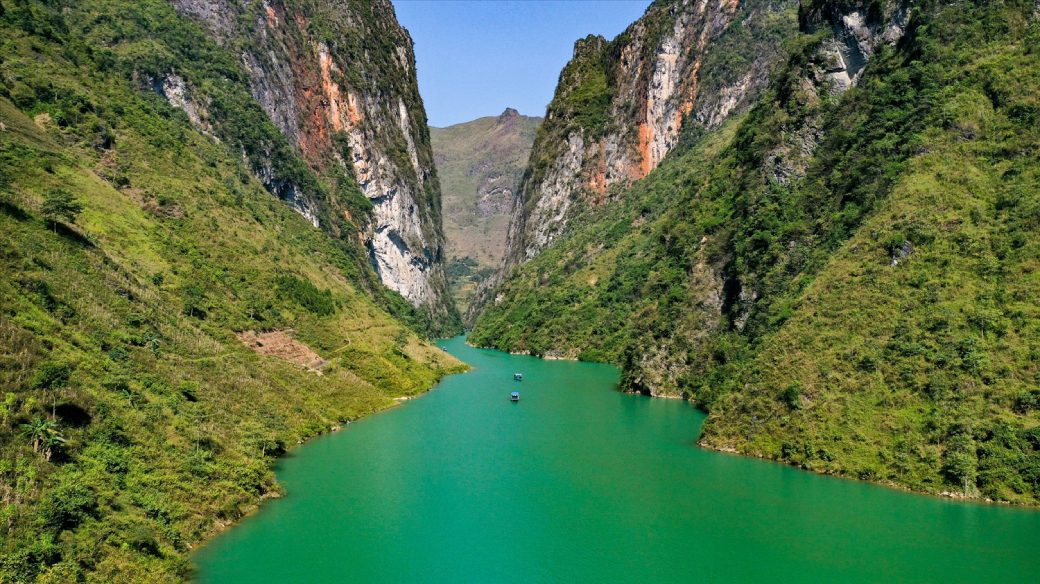
Tu San Gorge and Nho Que River from above - Source: Baodantoc.vn
5. Quan Ba Twin Mountains
Located about 4 km away in Lung Khau Nhin Commune, Quan Ba District, the Quan Ba Twin Mountains captivate visitors with their majestic and mysterious beauty. The two parallel peaks rise side by side like vertical walls against the sky, creating an enchanting and picturesque landscape.
The mountains are not only a natural artistic landscape but also hold cultural significance, linked to legends of love and maternal sacrifice. In 2009, Quan Ba Twin Mountains were officially designated a Vietnam Scenic Heritage Site.
6. Quan Ba Heaven Gate
Heaven’s Gate of Quan Ba is situated about 1,500 meters above sea level on a mountain along National Highway 4C in Quan Ba District, Ha Giang Province.
From this Heaven’s Gate, you can take in panoramic views of the majestic mountains, especially the iconic Quan Ba Twin Mountains. This Ha Giang's attraction is not only famous for its stunning natural beauty but also for its fascinating legends.
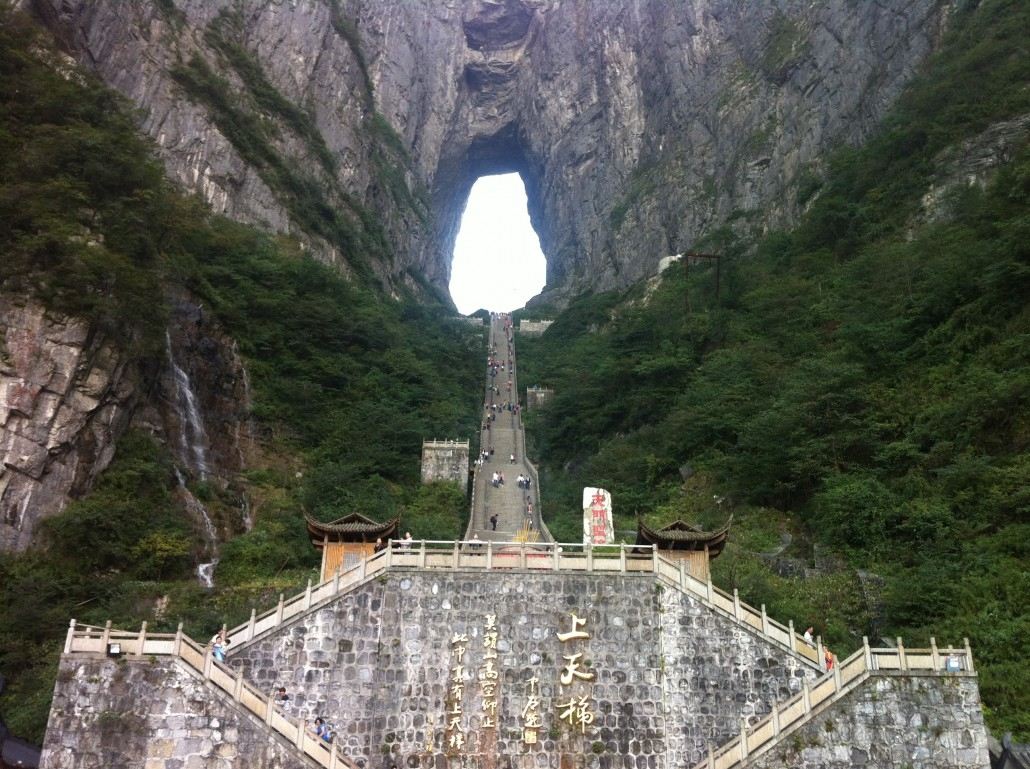
Source: Huonganhtourist
7. Khau Vai Love Market
The Khau Vai Love Market is a unique cultural event held only once a year on the 27th day of the third lunar month at Khau Vai Village, Khau Vai Commune, Meo Vac District, Ha Giang Province. It is not just a marketplace for trading goods and cultural activities but also a traditional gathering where young couples meet and socialise.
With a history spanning over 100 years, the Love Market was recognised in 2021 by the Ministry of Culture, Sports and Tourism as a National Intangible Cultural Heritage, honouring and preserving the social customs, cultural practices, and beliefs of this region.
8. Tha Village Cultural Tourism Community
Tha Village, located about 5 km from Ha Giang City in Phuong Do Commune, remains a pristine cultural site of the Tày ethnic group. The village features traditional stilt houses with palm roofs, green bamboo groves, lush green rice fields, and clear streams flowing around the village.
Coming here, you can experience the authentic rural life of the Tày people. You can often see local women weaving intricate brocade patterns on looms and sewing traditional garments. Do not miss the chance to enjoy local specialities during your visit.
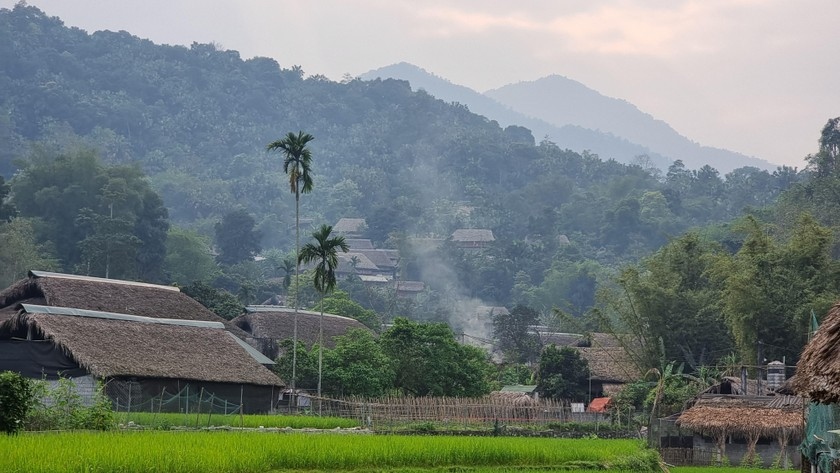
The rustic beauty of Tha cultural village - Source: Baophapluat
9. Tham Ma Pass
Tham Ma Pass is one of the most impressive slopes in Ha Giang, stretching about 5 km from Van Chai Commune to Lung Thau Commune, Dong Van District. The pass is famous for its challenging hairpin turns, making it a thrilling route for adventurous travellers.
The name "Thẩm Mã" comes from an old story where locals tested horses on this slope: only the horses that successfully climbed the pass remained to serve in transporting goods (Horse means Mã in Vietnamese).
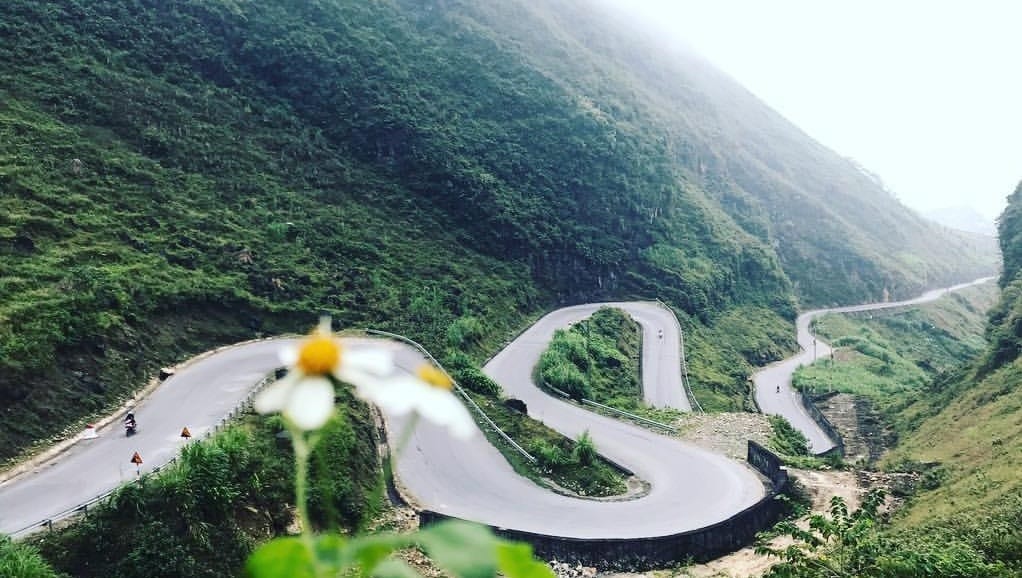
Source: Phuotvivu
10. Lung Cu Flagpole
The Lung Cu Flagpole stands at an elevation of 1,470 meters above sea level, located at the summit of Rồng Mountain in Lung Cu Commune, Dong Van District, Ha Giang Province. From the top of the flagpole, you can enjoy panoramic views of the majestic natural mountains surrounding the area and the rustic Lo Lo Chai Village.
The flagpole has undergone multiple restorations over time. Its current total height is recorded at 33.13 meters, including a base standing 20.25 meters tall with a diameter of 3.8 meters. The structure features an octagonal design, with eight stone relief panels decorated with Dong Son drum motifs and illustrations depicting various historical periods of Vietnam.
11. Lo Lo Chai Village
Lo Lo Chai Village lies at the foot of Lung Cu Flagpole Mountain in Lung Cu Commune, Dong Van District. It is home to the Lo Lo ethnic group, one of the smallest ethnic minorities in Vietnam, known for their unique culture and harmonious lifestyle with nature.
The village impresses visitors with its sturdy mud-walled houses, tiled roofs, and natural stone fences and gates that can hardly be found anywhere in Vietnam.

Source: Vnexpress
12. Dong Van Karst Plateau Geopark
Spanning four districts of Quan Ba, Yen Minh, Dong Van, and Meo Vac, the Dong Van Karst Plateau is a dramatic and enchanting landscape that captures the imagination of every traveler. This highland region rises between 1,000 to 1,600 meters above sea level and boasts spectacular limestone formations sculpted over hundreds of millions of years.
Recognised by UNESCO as Vietnam’s first Global Geopark in 2010, the Dong Van Karst Plateau is a geological wonder. Beyond its ancient rock formations, the plateau is home to diverse ecosystems and vibrant ethnic cultures, which maintain rich traditions and distinctive ways of life.
Travellers are drawn to this remote region not only for its stunning scenery but also for its authentic cultural experiences - colourful highland markets, traditional stone houses, historic relics, and warm local hospitality.
13. Dong Van Ancient Town
Situated within the core area of the Dong Van Karst Plateau Global Geopark in Dong Van Town, Dong Van District, this ancient town is where modern life meets tradition, which maintains its historical architecture while bustling with trade and activity. Dong Van Ancient Town was established in the early 20th century, with nearly 40 houses belonging to Tay, Chinese, and Mong ethnic families. Nowadays, it preserves a timeless charm with its classical architecture and quaint streets, taking visitors back in time.
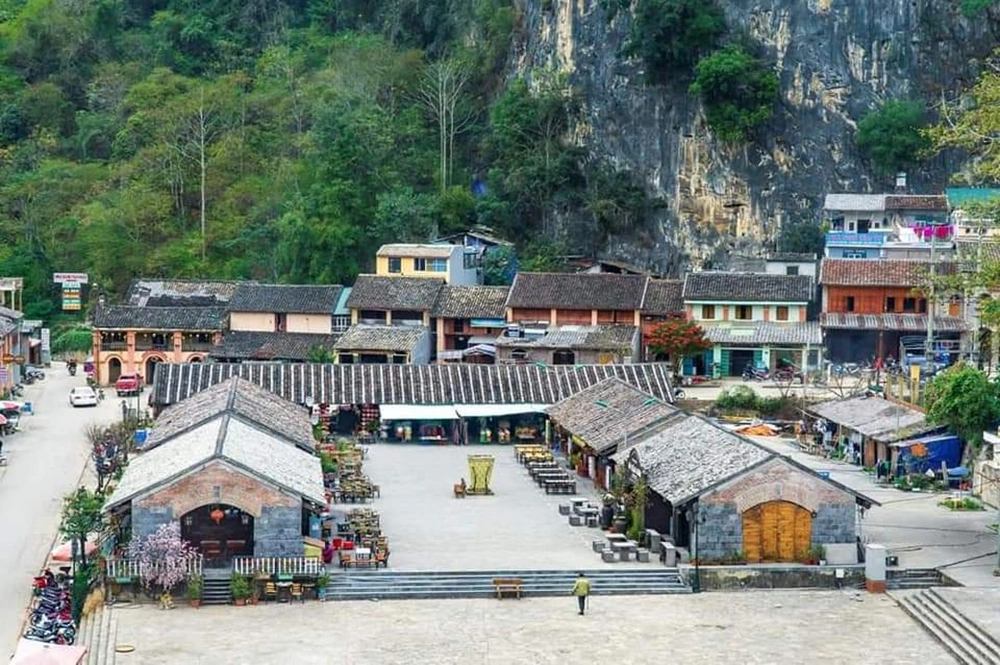
Source: Vnexpress
14. Du Gia Waterfall
Du Gia Waterfall, also called Ba Tien Waterfall, is located in Du Gia Commune, Yen Minh District. The waterfall’s powerful waters cascade continuously, creating beautiful white foam.
Known as the "Sleeping Fairy", it features a 6-meter-high cliff and a deep, emerald blue pool below. Coming here, you can try climbing the cliff and jumping from the 6-meter-high rock into the pool, an activity popular with Western tourists but potentially risky.
15. The Hmong King’s Palace
The Hmong King’s Palace is a historic architectural complex symbolising power and strength in ancient Ha Giang. Also known as the Vuong Mansion, where the King of this land used to live, the palace was built from 1898 to 1907, covering nearly 3,000 square meters, tucked away in Sa Phin Commune, Dong Van District.
Surrounded by a thick stone wall that evokes the image of a fortress, the palace is a stunning fusion of traditional H’mong architecture and classical Chinese design. Its layout follows a yin-yang philosophy with three main sections and 64 rooms, built primarily from precious wood, green stone, and terracotta tiles. The palace features intricately carved wooden beams, tiled courtyards, curved roofs with dragon motifs, and arched gateways—all harmoniously arranged to create an atmosphere of both elegance and authority.
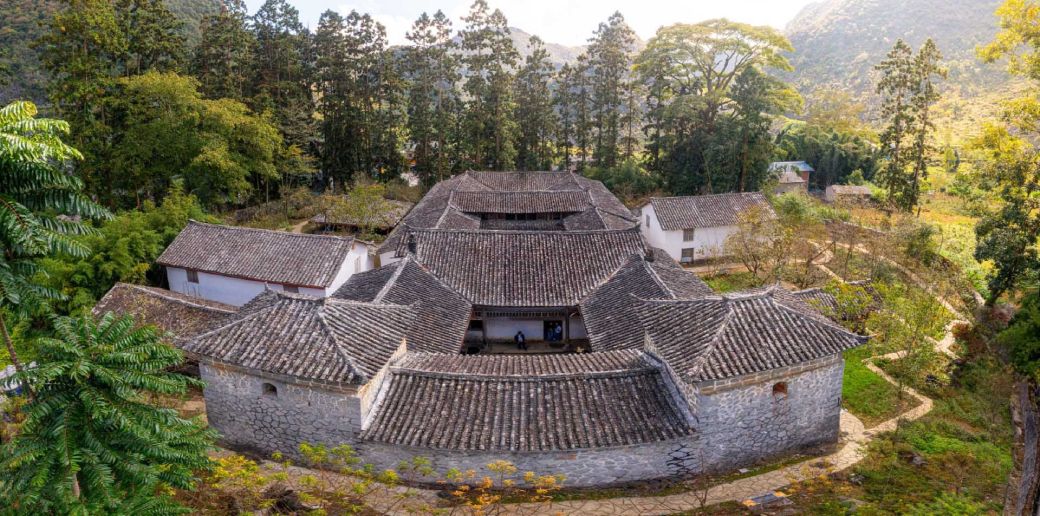
Source: Hanoitourist
16. Pho Bang Town
Pho Bang Town is a repository of many historical and cultural relics, making it an ideal stop for those interested in local heritage. Located 124 km from Ha Giang City along National Highway 4C, this small, peaceful town is well-known for its nostalgic beauty and separation from busy modern life.
Phó Bảng features traditional Chinese-style rammed earth houses with yellow-brown walls, moss-covered tiled roofs, and quiet narrow streets. The cool, tranquil atmosphere invites visitors to explore and enjoy a slower pace of life.
17. Sung La Valley
Sung La Valley is one of Vietnam’s most beautiful and highest plateaus, located in Sung La Commune, Dong Van District. With its magnificent landscape, the valley is home to the H’Mông ethnic community, offering visitors an opportunity to explore their traditional culture and customs.
Known as the “Flower of the Stone Plateau,” Sung La Valley captivates with its poetic beauty amid the rugged limestone mountains of Ha Giang. The area is famous for its vast fields of blooming buckwheat flowers, ancient H’Mông villages, and especially the Lũng Cẩm Cultural Village.
One notable attraction in Sung La Valley is Pao’s House, a 75-year-old traditional home. Owned by a H’Mông family, this house gained fame as the main filming location for the acclaimed Vietnamese film “The Story of Pao.”
Pao’s House features the classic H’Mông architectural style, constructed with rammed earth walls, a traditional yin-yang tiled roof, and an antique wooden gate. The house creates a peaceful and nostalgic atmosphere, making it a favourite destination for travelers.
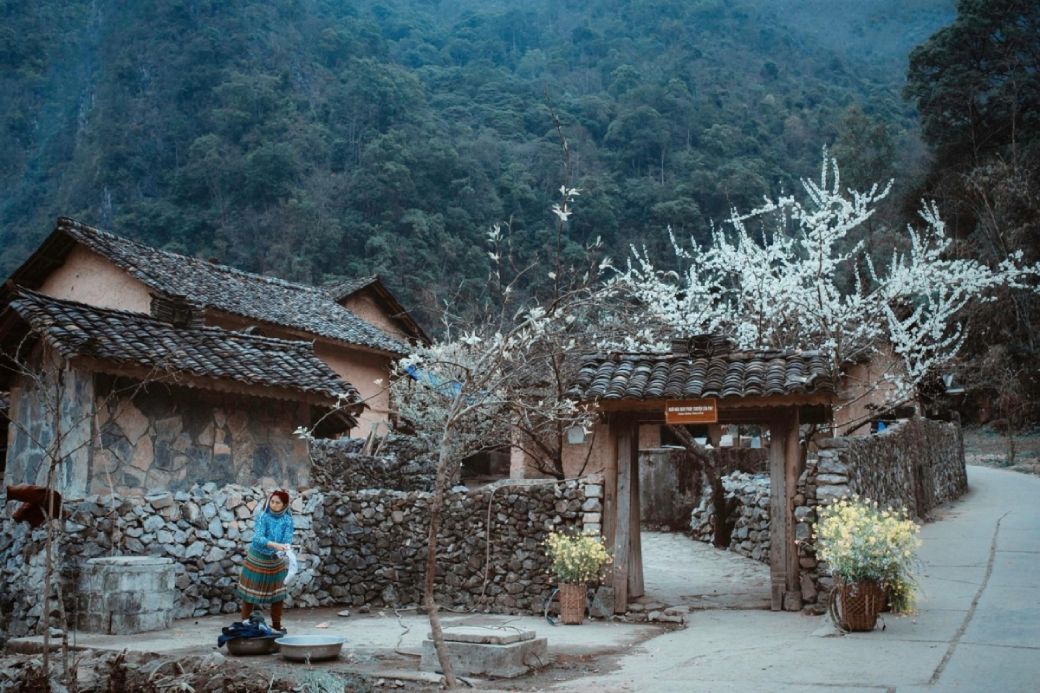
Source: Hagiangtv
Here is a list of 17 must-visit attractions in Ha Giang that you should not miss. As you can see, this remote land offers travelers hundreds of surprising experiences. A journey to explore Ha Giang is guaranteed to bring you countless unforgettable memories and unexpected delights.
